|
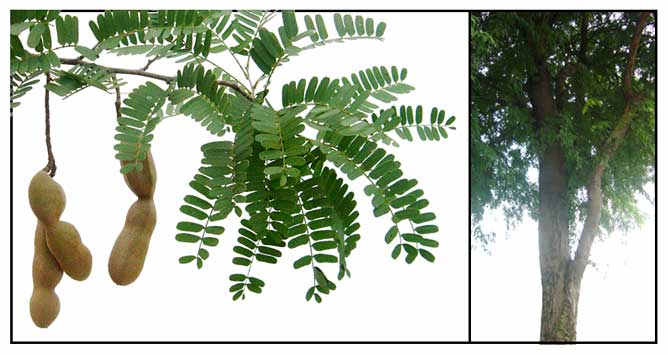 Botany Botany
Sampalok is a large tree
12 to 25 meters high, nearly glabrous. Leaves are evenly pinnate, 6 to 10 centimeters long, with 20 to 40 leaflets, rather
close, oblong, obtuse, 1 to 2 centimeters long. Racemes are mostly axillary though sometimes panicled, and reaching a length of 5 to 10 centimeters.
Calyx is about 1 centimeter long, the calyx tube turbinate,
the teeth lanceolate, much imbricated, the lower 2 connate. Petals are yellowish with pink
stripes, obovate-oblong, less than 1 centimeter long. Only the
3 upper petals developed, the 2 lateral ones ovate, the upper hooded,
the 2 lower ones reduced to scales. Stamens monadelphous, only 3 developed,
ovary many-ovuled. Fruits are pods oblong, thickened, 6 to 15 centimeters long, 2 to 3 centimeters
wide, slightly compressed, the exocarp thin and crustaceous, the mesocarp
pulpy acid and edible.
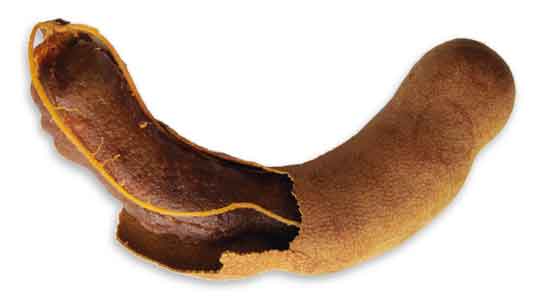 Distribution Distribution
- Planted throughout the settled areas of the Philippines.
- An attractive ornamental along avenues.
- Prehistoric introduction.
- Probably a native of tropical Africa.
- Pantropic in cultivation.
Constituents
- Fixed oil, 15-20%; citric,
acetic, butyric and oxalic acids; tannin; pectin.
- Various studies have shown high amounts of crude protein and essential amino acids, carbohydrates, minerals, potassium, phosphorus, calcium and magnesium.
- An analysis of tamarind pulp yielded: citric acid, 9.40; tartaric acid, 1.55; malic acid, 0.45; bitartrate of potash, 3.25; sugar, 12.5, gum, 4.7; vegetable jelly (pectin), 6.25; parenchyma, 34.35; and water, 27.55.
- Seed yielded tannin, a fixed oil, and insoluble matter. Analysis showed albuminoids, fat, carbohydrates, 63.22; fiber; and ash containing phosphorus and 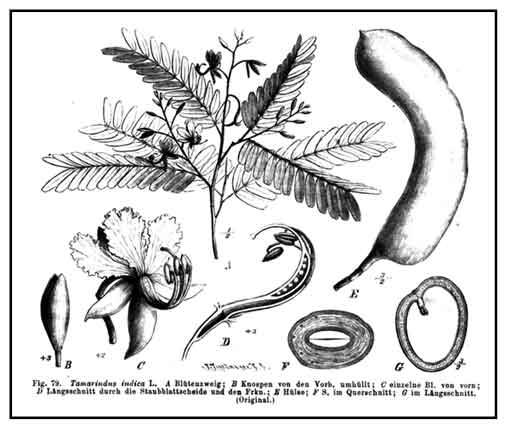 nitrogen. nitrogen.
- Fruit yields a trace of oxalic acid.
- Bark of old trees yield 7 per cent tannin.
-
Plant yielded thirty two fatty acids, two other compounds 9ß, 19-cyclo-4 ß4, 4, 14, ҳ-trimethyl-5ά-cholestan- 3ß-ol, 24R-ethyl cholest-5-en, 3β-ol and 12 essential elements viz., arsenic, calcium, cadmium, copper, iron, sodium, manganese, magnesium, potassium, phosphorus, lead, and zinc. The largest amount of SFAs is 14.5% n-heptadecanoate, 13.00% hexadecanoic acid and n-nonadecanoate, 6.1% n-octadecanoic, 5.00% methyl-n-pentacosanoic 4.45%, n-tetradecanoate 4.2 %, n- heptacosanoate 4.1%. The largest amount of (UFAs) is nenodecenoic acid 9.2 %,10-octadecenoicacid 7.8%, etc. (30)
- Elemental analysis yielded
(mg/kg) Mn 25.9, Ca 20.2, P 30.4, Na 10.9, As 54.25 µg/kg, Fe 14.07, Zn 8.52, K 7.16, Pb 0.27, Cd 3.36, Cu 0.76, Mg 60.1. (30)
- Nutrient analysis of fruit per 100 g yielded: (Principle) energy 239.00 Kcal, carbohydrates 62.50 g, protein 2.80 g, total fat 0.60 g, cholesterol 0 mg, dietary fiber 5.10 g; (Vitamins) folates 14.00 µg, niacin 1.938 mg, pantothenic
acid 0.143 mg, pyridoxine 0.066 mg, thiamin 0.428 mg, vitamin A 30 IU, vitamin C 3.5 mg, vitamin E 0.10 mg, vitamin K 2.80 µg; (Electrolytes) sodium 28 mg, potassium 628 mg; (Minerals) calcium 74.0 mg, copper 0.86 mg, iron 2.80 mg, magnesium 92.0 mg, phosphorus 113.00 mg, selenium 1.30 µg, zinc 0.10 mg; (Phytonutrients) carotene ß 19 µg, crypto-xanthin-ß 0 µg, lutein-zeaxanthin 0 µg. (USDA National Nutrient Data Base) (33)
- Leaf oil yields 13 components, with dominant components of linonene (24.4%) and benzyl benzoate (40.6%). Root bark yielded n-hexocane eicosanoic acid, ß-sitosterol, octacosanyl ferulate, 21-oxobehenic acid, and (+) -pinitol. Seeds major fatty acids are palmitic acid, oleic acid, linolenic acid, and eicosanoic acid. (46)
- Ethanolic extract of bark yielded saponins, quinine, alkaloids, lignin, and glycosides. (see study below) (56)
- Ethanol extract of seeds yielded alkaloids, flavonoids, carbohydrates, glycosides, and tannin phytoconstituents. (see study below) (60)
Properties
- Propagation by seed, soaked in water for 8 to 9 days before transplanting.
- Flowering from April
to October.
-
Astringent, tonic,
digestive, antiasthmatic, febrifuge, carminative, antiscorbutic,
antibilious.
- Bark is considered astringent and tonic.
- Pulp considered refrigerant and laxative.
- Seed and testa are astringent.
Parts used
· Leaves, fruits, flowers, and bark.
Uses
Edibility / Culinary / Nutrition
- As a souring condiment.
- Source of vitamins B and C.
- Sweetened and candied. The seeds, surrounded by a brownish pulp, tamarindo, are made into balls from which jams, sweets and drinks are made. The pulp, malasebo, is often eaten outright, with or without salt. The pulp is also an ingredient in Indian curries and chutnies.
- In India, seeds are eaten after the outer skin has been removed by roasting or soaking; then boiled or fried.
- The seed is sometimes used as famine food by aboriginal tribes.
- Young leaves and very young seedlings and flowers are cooked and eaten as greens and used popularly in the Philippines for seasoning "sinigang," and in India for curries. In Zimbabwe, leaves used in soups, flowers in salads.
- In some part of tropical America, a fermented drink is made from the pulp.
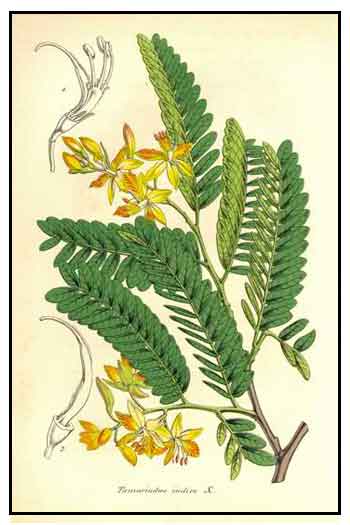 Folkloric Folkloric
• In the Philippines, the bark, leaves, flowers, fruits, and seeds are used medicinally in the way it is used in other countries.
• Decoction of leaves used as an aromatic bath for fevers, puerperism, and convalescence.
• Fever: Macerate pulp or ripe fruit in water,
sweeten to taste, and drink.
• Laxative: Pulp is considered a mild laxative because of the presence of potassium bitartrate. Eat pulp of ripe fruit liberally
and follow with plenty of water.
• Asthma: Bark; chop and boil a foot-long piece
of bark in 3 glasses of water for 10 minutes. Adults, 1 cup after every
meal and at bedtime; children, 1/2 cup 4 times daily; babies, 2 tbsp
4 times daily.
• Decoction of ash: For colic, indigestion; as gargle for sore throats,
aphthous sores.
• Ash is considered astringent and tonic; used internally as a digestive. Ash preparation: Fry the bark with common salt in an earthen pot until
it turns to powdered white ash; a heaping teaspoon of the ash to half-cup of boiling
water; cool and drink for colic and indigestion.
• Poultice or lotion from bark applied to ulcers, boils, and rashes.
• Poultice of leaves to inflammatory swellings of ankles and joints.
• Decoction of leaves as postpartum tea; also used as a wash for indolent
ulcers.
• Flowers used for conjunctival inflammation. Internally, as decoction or infusion,
for bleeding piles (4 glasses of tea daily).
• Pulp surrounding the seeds is considered cooling and a gentle laxative.
• Gargle of tamarind water used for healing aphthous ulcers and sore throat.
• Tamarind pulp considered preventive and curative for scurvy.
• In Mauritius, the Creoles mix salt with the pulp and use it as a liniment for rheumatism.
• Tamarind infusion considered carminative and digestive, antiscorbutic and antibilious.
• Young leaves used as fomentation for rheumatism and applied to sores and wounds.
• In Malaya decoction of leaves used for fevers.
• The leaves crushed with water and expressed, used for bilious fever and in scalding of urine.
• Poultice of leaves crushed in water used for ankle and joint inflammations to reduce swelling and pain.
• Decoction of leaves used as a wash for indolent ulcers.
• Poultice of flowers used for conjunctival inflammation. Juice expressed from flowers used internally for bleeding piles.
• In rural India where natural spring water yields high amounts of fluoride, a small amount of tamarind fruit is added to a pot of water overnight to be used for drinking. (See fluoride toxicity amelioration) (18)
• Juice of leaves, warmed by dipping a red hot iron, used in dysentery.
• Powdered seeds are given in dysentery; boiled and decocted, used as a poultice for boils.
• In Cambodia, filtered hot juice of leaves used for conjunctivitis.
• In the West Indies, decoction of leaves used jaundice and for worms in children.
• Hindu physicians apply pounded leaves to erysipelas.
• In Mauritius a bark decoction is used for asthma.
• In Madagascar, bark decoction used for asthma and amenorrhea.
• In East Sudan, the bark is considered tonic and febrifuge.
Others
- Dyeing / Mordant: Leaves and flowers useful as mordants in dyeing. Yellow dye from the leaves colors wool red and turns indigo-dyed silk to green. Leaves used in bleaching buri palm to prepare it for hat making. In Java, an ink is obtained by burning the bark. The Hindus Kamaras use the starch in doll painting.
- Fodder: Leaves eaten by cattle and goats. Also, a fodder for silkworms.
- Nectar: Flowers are considered a good source of nectar for honeybees in South India.
- Seeds: Powder from tamarind kernels used in the Indian textile industry in several processes - sizing, finishing cotton, jute and spun viscose.
- Wood: Highly prized for furniture, paneling, wheels, axles, mill gears, planking, mallets, handles, walking sticks, etc. In Mexico, wood is used for boiling purposes and provided an excellent source of charcoal for the manufacture of gunpowder.
- Oil: Seeds yield an amber oil, useful as illuminant and a varnish.
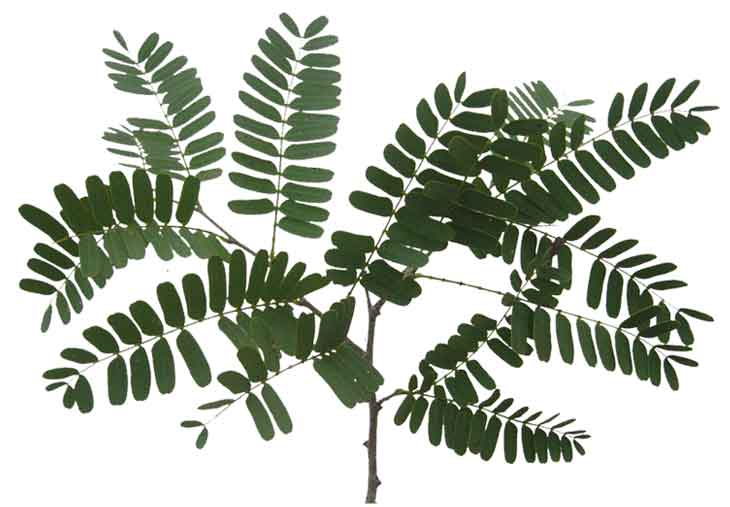
Studies
• Antibacterial:
Aqueous pulp extract study showed antibacterial activity against all
strains tested. Phytochemical screening yielded saponins, alkaloids and
glycosides. Study confirms the traditional use of the plant for the treatment
of infections. (1)
• Antibacterial: Study evaluated the antibacterial activity of extracts from T. indica ripe fruit and Piper nigrum seed against S aureus, E coli, P aeruginosa and Salmonella typhi. The ethanol extract of T indica showed higher activity against all test bacteria than that from P nigrum.
• Hepatoprotective / Paracetamol Induced Toxicity:
Study showed a significant hepatoprotective effect with the aqueous
extracts of tamarind leaves, fruits and unroasted seeds on paracetamol
intoxicated rats. (2) Study evaluated the protective effects of ethanolic extract of T. indica leaves and seeds in comparison to vitamin E on paracetamol induced hepatotoxicity in Long Evans rats. Results showed hepatoprotective activity comparable to vitamin E, a known hepatoprotective agent. (31)
• Anti-venom activity:
Extracts of tamarind inhibited the major hydrolytic enzymes of early
envenomation (local tissue damage, inflammation, hypotension). It also
neutralized indirect hemolysis. It presents an alternative to serum
therapy. (3)
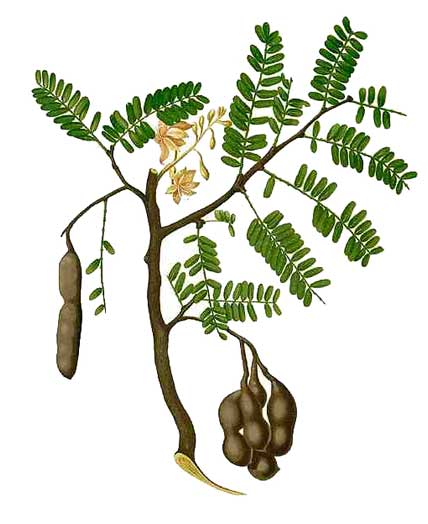 • Aspirin Bioavailability:
Study showed Tamarindus indica fruit extract significantly increased
the bioavailability of aspirin. (4) • Aspirin Bioavailability:
Study showed Tamarindus indica fruit extract significantly increased
the bioavailability of aspirin. (4)
• Cosmetic Potential:
Seed husk extract with polyphenolic components (Polyant-T) was tested
for antioxidant efficiency and provides a potential use for color cosmetics
and sunscreens. (5)
• Hypolipidemic / Blood Pressure Effect / Fruits:
Fruits were evaluated for effects on lipid profile, blood pressure and weight. Dried and pulverized pulp of fruits showed a beneficial effect on the lipid profile with a significant
lowering of the total and LDL-cholesterol without affecting the HDL level.
There was also a significant reduction of diastolic blood pressure. (6)
• Chemical Constituents:
Study revealed the presence of 21 saturated (67.5%) and 11 unsaturated fatty acids (30.15%). The results showed great variation in fatty acids, elemental composition and total protein attributed to environmental and ecological factors.
• Anti-Diabetic / Seeds / Pancreatic Islets: Study of aqueous extract of Tamarindus indica seeds against STZ-induced damages in pancreatic islands showed AETIS partially restores pancreatic beta cells and repairs STZ-induced damages in rats. (10)
• Anti-Diabetic / Seeds: Study of aqueous extract of seed showed potent antidiabetogenic activity that reduces blood sugar in streptozotocin-induced diabetic male rat. (14) Study evaluated the hypoglycemic and anti-hyperglycemic activity of T. indica seed powder in non-diabetic and diabetic rat models. Results showed significant antihyperglycemic activity in T2 diabetic rat model, attributed, at least in part, to inhibition of intestinal glucose absorption. (36) (42) A hydromethanolic extract of T. indica seed showed antihyperlipidemic and antihyperglycemic effects with potential benefits in diabetes related complications. (54) Study in alloxan-induced diabetic rats showed a hydroethanolic seed coat extract of T. indica possessed potent hypoglycemic action by virtue of its phytoconstituents. The HETI exerted protective effect on pancreatic ß-cells as noted on histopathology of animals. (69)
• Anti-Diabetic / Fruits and Seeds: Study showed extracts of both fruit and seeds significantly lowered blood glucose levels in mice compared to control.(16)
• Anti-Melioidosis: Melioidosis, caused by Burkholderia pseudomallei, is a life-threatening infection common among paddy cultivators in Southeast Asian countries. Study showed the methanolic extracts of T indica has anti-B. pseudomallei inhibitory potentials under in-vitro conditions. (11)
• Spasmolytic: Study of the methanolic extract of fruits of Tamarindus indica on rabbit's jejunum preparations showed relaxing effects probably through calcium channel blockade. (12)
• Genotoxicity Study: Study of Tamarindus indica fruit pulp extract was devoid of clastogenic and genotoxic activities in cells of rodents, when administered orally at three acute doses. (13)
• Antioxidant: Study of T indica seed coat extract was found to possess strong antioxidant activity attributed to free radical scavenging activity. (15)
• Analgesic / Fruit: Study showed the aqueous fruit extract of T indica in rodent models using acetic acid-induced writhing, hot plate and formalin tests showed potential antinociceptive activity at both peripheral and central levels, mediated via an opioidergic mechanism. (17)
• Fluoride Toxicity Amelioration: Fluoride is a cumulative poison, toxicity leading to bony and dental lesions developing over a period of time. Study showed the extracts of both T. indica and M. oleifera have some potential to mitigate fluoride toxicity. Changes in plasma biochemistry suggested less hepatic and renal damages in animals receiving plant extracts along with fluorinated water compared to those receiving fluorinated water alone. (18)
• Anthelmintic: Study using an Indian earthworm as test worm confirmed T. indica's anthelmintic activity. The root extract not only demonstrated paralysis and also caused death in a shorter period of time compared to the reference drug Piperazine citrate. (19)
• Acute Toxicity / Hepatotoxicokinetic Studies / Stem Bark: A crude extract of stem-bark was evaluated for toxicity and hepatotoxicokinetics on Wistar rats. Brine shrimp lethality assessment resulted in 70% (200 µg/mL) and 10% (20µg/mL) nauplii death with crude extract. Hepatotoxicokinetics dosing wistar rats with crude fractions at 25% and 50% of predetermined LD50 on chicken embryos showed elevation in the AST and ALT. Results suggest that dose standardization in folk herbal medicine is imperative as T. indica used as food and medicine has been shown to be toxic at high doses. (22)
• Antibacterial / Stem Bark and Leaves / Fruit Pulp: Phytochemical studies yielded tannins, saponins, sesquiterpenes, alkaloids, and phlobatamins. Extracts of stem bark and leaves were active against both gram positive and gram negative bacteria. (23) Study evaluated ethanolic and aqueous extracts of fruit pulp, stem, bark, and leaves for in vitro antibacterial activity against 13 Gram negative and 5 Gram positive bacterial strains. Fruit pulp extract exhibited wide spectrum of activity against bacterial strains, 95.5% for the cold water extract, and 90.9% and 86.4% for the hot water and ethanolic extracts, respectively. (48)
• ENO1 / Effect on Alpha Enolase Release / Lipid Effects: Study of a methanol extract of T. indica fruit pulp altered the release of ENO1, ApoA-I, TTR and GDI-2 from HepG2 cells. Results support the effect of T. indica on cellular lipid metabolism, particularly that of cholesterol. (24)
• Antibacterial / Pulp Extract: Study evaluated an aqueous pulp extract of T. indica against four bacteria (E coli, S aureus, P aeruginosa and S typhi). The extract showed activity against tested bacteria: S. aureus >E coli>P aeruginosa. (25)
• Hepatoprotective / CCl4-Hepatotoxicity: Study in Wistar rats showed an ethanolic extract of fruit pulp of Tamarindus indica ameliorated the damage caused by CCl4, with lowering of enzymes and bilirubin, further verified by histopathological improvement. (26)
• Antioxidative / Diabetic Benefits / Bark: Study evaluated the antioxidative effect of an ethanolic extract of bark of T. indica to normoglycemic and alloxan-induced diabetic rats. Results showed a significant decrease in peroxidation products, an increase in glutathione and glycogen content. The extract exhibited antioxidant property and an antidiabetic effect more effective than glibenclamide. (27)
• Tamarindus indica seed polysaccharide (TSP) Eye Drops / Dry Eye Syndrome: Clinical trials evaluated a form of eye drops utilizing Tamarindus indica seed polysaccharide for the treatment of severe dry eyes, including Sjogren's syndrome, for patients sensitive to preservatives. Results showed long lasting effect, clinical improvement in dry eye symptoms, compatibility with contact lenses, and mucomimetic properties. (28)
• Hypocholesterolemic / Antioxidant / Fruit Pulp: Study postulates that tamarind fruit pulp exerts hypocholesterolemic effect by increasing cholesterol efflux, enhancing LDL-C uptake and clearance, suppressing triglyceride accumulation and inhibiting cholesterol biosynthesis. The fruit pulp extract has potential antioxidative effects and is potentially protective against diet induced hypercholesterolemia. (32)
• Ameliorative Effect in Renal Cancer: Study analyzed the histological alterations and oxidative stress markers in an experimental animal model in N-diethylnitrosamine-initiated and ferric nitrilotriacetate-promoted renal cell carcinoma and the effect of seed extract against acute nephrotoxicity and carcinogenesis. In the acute study, the TSE ameliorate necrosis and renal failure. TSE also decreased both oxidative stress markers and decreased renal cell carcinoma progression. (34)
• Defluoridation / Biosorbent for Removal of Fluoride Ions: Study showed tamarind fruit cover in its natural and acid treated forms has a potential for use as an alternative biosorbing agent in the removal of fluoride ions from aqueous media. (35)
• Biosorption of Chromium / Fruit Shell: Study investigated the use of crude tamarind fruit shell in the adsorption of chromium (VI) ions from aqueous solutions. Results showed outstanding adsorption capacities and suggests a potential and excellent alternative sorbent for the removal of chromium ions. (39)
• Removal of Dye from Textile Effluent / Hull: Study evaluated the use of Tamarind hull as biosorbent to remove cationic dye from textile effluent. Results of adsorption kinetics showed Tamarind hull has potential as biosorbent to remove cationic dyes from contaminated watercourses. (43)
• Antidiabetic / Hepatoprotective / Hypolipidemic / Fruit Pulp: Study investigated the antidiabetic, hypolipidemic, and hepatoprotective of ethanolic extract of fruit pulp in alloxan induced diabetic rats. Results showed significant alterations in alloxan induced changes in serum glucose, lipid profile and serum enzyme levels. (37)
• In Vitro Anticataract Activity: Study evaluated the efficacy of T. indica on preventing cataract formation in vitro on galactose induced cataract model in model of goat lenses. Results showed cataractous lenses showed higher MDA and water-soluble protein content. Lenses treated with T. indica showed higher protein content and prevented formation and progression of cataract by galactose. (38)
• Hypolipidemic / Fruit Flesh and Rind: Study evaluated the hypolipidemic effects of 70% ethanolic extract of T. indica fruit flesh and rind in male Wistar rats with Tirton X-100 induced hyperlipidemia. Results showed the extracts of fruit rind and flesh can significantly (p<0.01) reduce total plasma cholesterol and triglycerides. (40)
• Anti-Snake Venom / Seeds: Study evaluated aqueous and alcoholic extracts of dried seed powder of T. indica for antioxidant and inhibitory activity on toxic enzymes like PLA2 and proteinases of Naja naja venom. Results suggest the methanolic extract of seeds possess compounds that inhibit the activity of Phospholipase A2 and Proteinases of cobra venom. It presents a rich source of potential toxin inhibitors and a potential alternative treatment to serum therapy. (41)
• Antioxidant / Fatty Acid Profile / Tocopherols / Seeds: Study evaluated the composition of seeds re its antioxidant potential, fatty acid profile and tocopherol content. Results showed seed have high content of carbohydrates (71.91%) with relevant content and antioxidant activity of phenolic compounds. Seed oil showed high oxidative stability and significant total tocopherol content (57.77 mg/kg). It also showed a higher percentage of unsaturated fatty acids, its main component being linolenic (59.61%), an essential fatty acid. (44)
• Ameliorative Effect on Cattle Fluorosis / Fruit Pulp: Study studies dried powder of tamarind pulp in endemic fluorosis in cattle. Results showed the fruit pulp has ameliorative potential on management of fluorosis in cattle. (45)
• Effect on Gene Expression in HepG2 Cells / Antioxidant
/ Leaves: Study sowed antioxidant-riich leaf extract of T. indica showed protective effects in HepG2 cells by inhibiting lipid peroxidation, suppressing ROS production, and enhancing antioxidant enzyme activities. The leaf extract also directly targeted the expression of genes and encoded proteins involved in the coagulation system and antimicrobial response providing molecular evidence associated with the medicinal properties of the leaf extract. (46)
• Antimicrobial / Leaves / Bark: Study evaluated decoctions from fresh and sun dried leaves in 30 and 70% ethanol-water and the pure essential oil from leaves against B. subtilis, E. faecalis, S. aureus, E. coli, S. typhymurium, P. aeruginosa, and Candida albicans. Phenols were active compounds against B. subtilis cultures. Essential oil exhibited good antimicrobial spectrum. Common folk preparations, however, fail to provide good activity in these extracts. (47) Study evaluated the antimicrobial activity of ethanolic bark extract of Tamarindus indica for antimicrobial activity. Large zones of inhibition was observed with S. aureus and B. cereus at 16 mm and 15.25 mm, respectively. (see constituents above) (56)
• Anti-Aging Potential /
Seeds: Study investigated the anti-aging potential of antioxidants present in T. indica seeds extract in a water-in-oil cosmetic emulsion formulation. Results showed statistically significant (p<0.05) effects on skin elasticity and skin moisture contents, together with a significant decline in SELS (surface evaluation of living skin), skin scaliness (SEsc), skin wrinkles (SEw), skin smoothness (SEsm) and skin roughness (SEr) parameters after application of the formulation. Anti-aging effects were attributed to various antioxidants in the seeds extract. (49)
• Amelioration of Adjuvant Induced Arthritis / Seeds: Study investigated the anti-arthritic efficacy of Tamarind seed extract. TSE exhibited cartilage and bone protecting activity by inhibition of elevated activities of MMPs, HAase, exoclycosidases, cathepsins and TRAP, also mitigating the augmented levels of inflammatory mediators. Results suggest TSE as a potent agent abrogating arthritis-mediated cartilage/bone degradation, inflammation, and associated stress in vivo. (50)
• Chronic Toxicity Study / Pulp: Study evaluated the safety of long-term use of tamarind pulp water extract in Wistar rats at various doses from 75 to 1000 mg/kbw per day for six months. After six months, there were not significant change in body weight, hematologic, and clinical biochemistry profiles of the tested group. Results showed tamarind pulp extract was generally safe and well tolerated at the tested dose. (52)
• Tamarind Seed Flour as Food Ingredient: Study demonstrated the effect of fermentation, roasting and germination in the enhancement of functional and nutritional properties of tamarind seed flour for utilization as food ingredient. (53)
• Potential for Cancer Treatment / Leaves: Study evaluated the anticancer potential of various solvent extracts leaves of Tamarindus indica Linn using HL-60 cell line. The petroleum ether extract of leaves showed more potency than other extracts and suggests a potential in the prevention and management of cancer cell growth. (55)
• Potential Source of Vinegar / Fruit Pulp: Study evaluated the physiochemical properties and antioxidant content of tamarind fruit pulp and its potential use in vinegar production. Study determined the fermentation process, physical properties of ethanol from the samples with regards refractive index and concentration. Results suggest the fruit pulp could be use in vinegar production. (57)
• Weight Reducing / Hypolipidemic
/ Fruit Pulp: Study evaluated the effect of ethanolic extract of fruit pulp of T. indica on obesity in rats using cafeteria diet-induced obesity and antipsychotic drug (sulpiride)-induced obesity. The ethanolic extract of fruit pulp showed significant weight reducing and hypolipidemic activity as evidenced by significant decrease in body weight, serum cholesterol and triglycerides and significant increase in HDL cholesterol. (58)
• Neuroprotective on Prenatal Ethanol Exposure /
Pulp Extract: Ethanol consumption during pregnancy has been shown to jeopardize the health of the mother and embryo. Study evaluated effect of T. indica pulp extract on histological and biochemical changes on cerebral cortex in Wistar rats exposed to prenatal ethanol. Study suggest the TI pulp extract has potential protective effect on the cerebral cortex of Wistar rats during prenatal ethanol exposure. (59)
• Antidiarrheal / Acute Toxicity Study / Seeds: Study evaluated the antidiarrheal activity of ethanolic extract of seeds in a castor oil-induced diarrhea model in albino Wistar rats. The extract showed no toxic effect or mortality up to 2000 mg/kg PO dose for 48 hours and up to 14 days. Seed extract showed significant antidiarrheal activity of 78.23% at dose of 400 mg/kg. Effect may be attributed to the presence of flavonoids and tannins in the seed extract. (see constituents above) (60)
• Protease Inhibitory Peptides / Seeds: Study evaluated the total soluble protein/peptide content and protease inhibitory peptides from the seeds of T. indica. Fermentation and protease treated cold storage process produced bioactive peptides that showed significant proteolytic inhibition which has potential use in the treatment of several human pathologies. (61)
• Haematinic Activity / Leaves: Study evaluated the haematinic activity of oral indiffusible mixture of T. indica leaf extract in phenylhydrazine induced anemia in Wistar albino rats. Results showed statistically significant improvement in the level of RBC and Hb (p<0.05) at dose of 200 mg/kg. Study postulates the haematinic activity may be due to the presence of flavonoids, phenols, saponins, and tannins. (62)
• Synergistic Antiproliferative Activity /
T. indica and P. glaucum: Study evaluated the growth inhibitory potential of various extracts of Pennisetum glaucum (pearl millet) and Tamarindus indica singly or in combination on cervical (HeLa), prostate (DU 145) and breast (HCC-1395) cancerous cell lines. Tamarindus indicus whole fruit methanol-dichlormethane extract had the highest activity against the cell lines. The combination of pearl millet and tamarind showed synergistic action against the cancer cells. Synergism was observed when the extracts were combined with 5-fluorouracil. Results suggested 5-FU dosage could be reduced while achieving the same effect (DRI>1). Further studies are suggested to determine bioactive compounds and mechanism of growth inhibitory action. (63)
• Diuretic / Ripe Fruit Pulp: Study evaluated an aqueous extract of fruit pulp for diuretic activity compared with standard furosemide in Wistar rats. At dose of 1200 mg/kg, the aqueous extract of fruit pulp exhibited significant diuretic activity (p<0.05) without significant natriuretic effect. Magnesium excretion was significantly increased compared to control group. (64)
• Aphrodisiac / Toxicity Study / Pulp: Study evaluated the aphrodisiac potential and reproductive safety profile of aqueous extract of macerated pulp of T. indica in male Wistar rats. The extract was found safe up to 2000 mg/kg po. Results showed significant (p<0.05) improvement in parameters of sexual desire (mount frequency and intromission frequency) and parameters of sexual arousal. Histopathology and sperm count suggested increase in sperm production without any sign of toxicity to testis. Sperm motility significantly (p<0.05) increased in the treatment group. (65)
• Silver Nanoparticles / Antibacterial / Anticancer / Seed Coat Extract: Study reports on the synthesis of silver nanoparticles using an aqueous extract of seed coat as reducing and capping agent. The synthesized silver nanoparticles showed excelled antibacterial and anticancer properties. (66)
• Gold Nanoparticles
/ Leaves: Study reports on the biosynthesis of gold nanoparticles using an extract of T. indica leaves. Phenols, ketones, and carboxyls were present in the leaves. Study showed T. indica leaves extract as efficient raw material for the synthesis of spherical gold nanoparticles. (67)
• Cleaner of Root Canal Wall Smear Layer: Study evaluated the ability of 5% T. indica extract as a root canal irrigant to remove root canal wall smear layer. Results showed the hygiene value of 5% T. indica extract was higher than sterile aquabidest and can be used to remove root canal wall smear layer. (68)
Availability
- Wild-crafted.
- Cultivated for fruiting and culinary use.
- Sweetened and candied.
|



